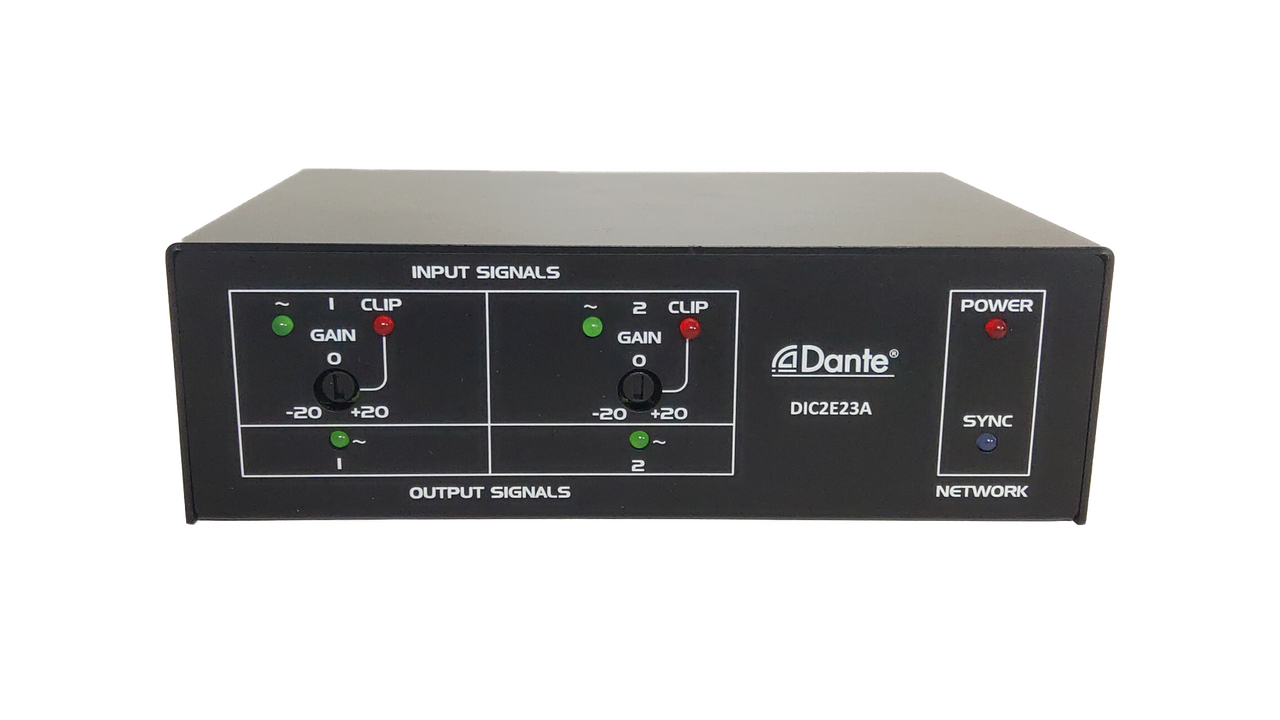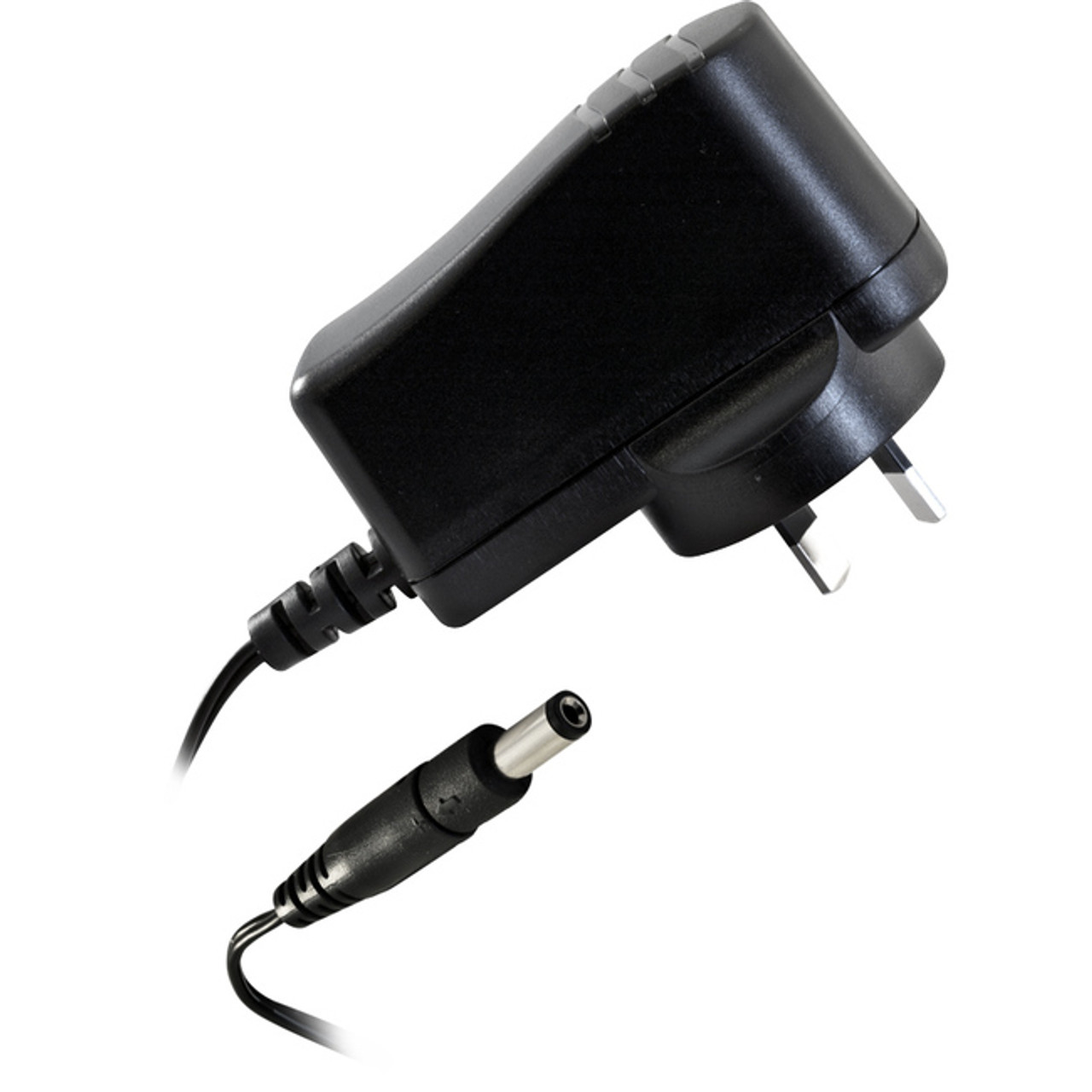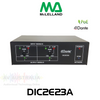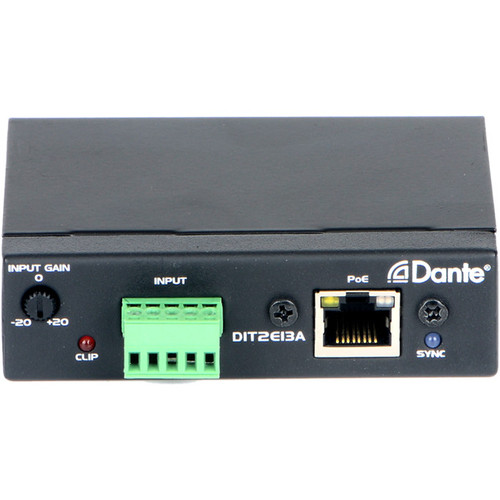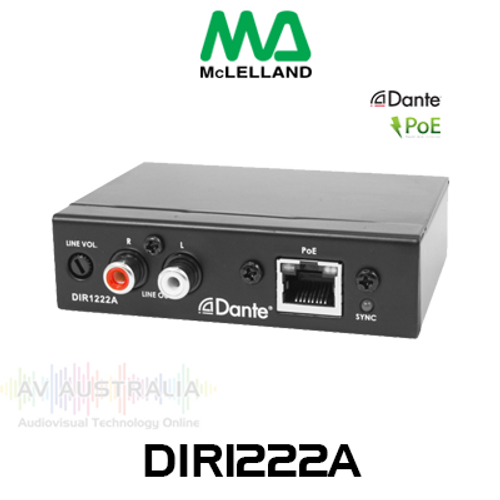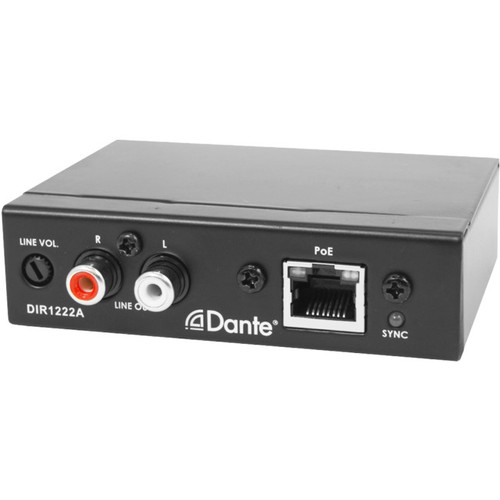Product Description
Key Features
• Provides Dante Interface for two Inputs / Outputs
• Accepts Balanced or Unbalanced Signal Inputs
• MIC/LINE selectable on Each Input
• Gain control on each input; Gain control on output channels
• Provides 48V Phantom Power for Each Condenser Microphone Input
• High Resolution 24 Bit Converts Analog to Digital and Digital to Analog
• Two Standard MIC or LINE Audio Channels Converts to Dante Network
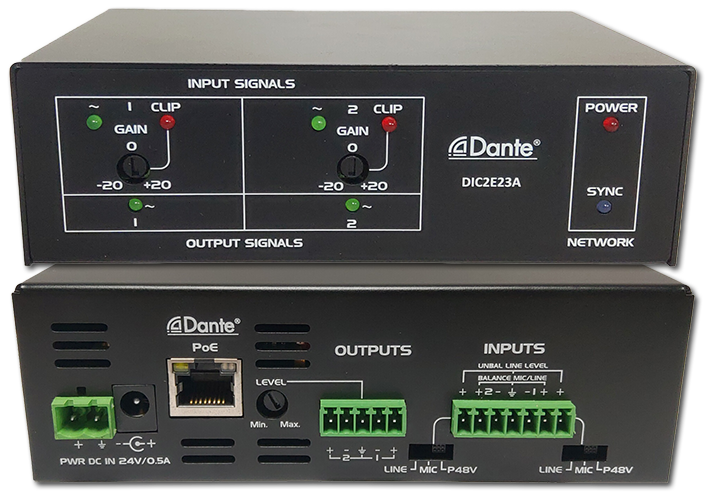
Dante Interface 2 Mic/Line Inputs x 2 Outputs
DIC2E23A is a high quality Dante interface box for converting two Dante channels to Analogue Audio outputs, and two Analogue Audio inputs to Dante network.
Features
- Two Mic/Line Terminal Block Inputs on Rear Panel
- Converts Mic or Line Audio Signals to 2 Channels Dante Network
- Switchable Mic/Line/48V Phantom Power for Each Input
- Terminal Block for Two Audio Outputs on Rear Panel
- Two Audio Signal Outputs from Dante Network
- Converts 2 Channels Dante Signals to Two Line Terminal Block Outputs
- Balanced or Unbalanced Signals for Inputs and Outputs
- Adjustable Gain Control for Output Level on Rear Panel
- LED indicators for Signal Level and Clip of Each Input Channel on Front Panel
- Adjustable Gain from -20 dB to 20dB for Each Input Channel on Front Panel
- LED indicators for Signal Level of Each Output Channel on Front Panel
- Power over Ethernet (PoE) OR 24VDC power supply (NOT INCLUDED)
- LED Indicators Show the Status of Power and Network
- High Resolution 24 Bit for DAC and ADC
- Provides High Quality of Preamplifier for Microphones
- Dimension: 143mm x 45mm x 93mm (WHD)
Specifications
Dante Network to Line Level Outputs
- Outputs : 5P Detachable Terminal block, Balanced/Unbalanced
- Output Level: -10 dBu nominal
- Output Level: +10 dBu Maximum
- Output Voltage: +20dBu (@ 0dB output gain)
- Output Impedance: 150 Ω balanced; 75 Ω unbalanced
- Frequency Response: 20 Hz to 20 kHz (± 0.5 dB)
- THD+N: < 0.1%
- Noise: <-75dB
- Crosstalk: < 85 dB (20 Hz to 20 kHz)
Mic/Line Inputs to Dante Network
Mic Inputs
- Inputs :7 Pin Euro Terminal, Balanced
- Gain: Condenser microphone :40 dB
- Dynamic microphone : 60 dB
- Input Level for +4 dBu: -36 dBu (Condenser)
- -56 dBu (Dynamic)
- -36 dBu(Maximum)
- Input Impedance: 40 Ω
- Phantom Power: 48 V
- Frequency Response: 20 Hz to 20 kHz (± 0.5 dB)
- THD+N: < 0.1%
- Noise below +4 dBu: < -70 dB
- CMRR: > 70 dB (50 Hz to 120 Hz)
- Crosstalk: < 70 dB (20 Hz to 20 kHz)
Line Inputs
- Inputs : 7 Pin Euro Terminal, Balanced
- Input Level for +4 dBu: +4 dBu (balanced); -10 dBV (unbalanced)
- Input Impedance: >40 Ω
- Frequency Response: 20 Hz to 20 kHz (± 0.5 dB)
- THD+N: < 0.1%
- Noise below +4 dBu: < -75 dB
- CMRR: > 60 dB (50 Hz to 120 Hz)
- Crosstalk: < 75 dB (1 kHz, any line to any mic channel), < 70 dB (20 Hz to 20 kHz)
- Headroom above +4 dBu: > 18 dB
Dante channel
- Transmitters/Receivers: 4/4
- Transmission rate: 100 Mbps
- Resolution: 16/24/32 Bit
- Sampling rate: 44.1 kHz, 48 kHz.
- Dante interface: RJ45 jack
- Power Connections :2 Pin Euro Terminal, Power Jack
- Power Requirement: 24 Vdc @ 180 mA plus connected phantom loads, or PoE
- Dimensions: 143mm(W) × 45mm(H) × 93mm(D)
- Weight: 0.7Kgs
Optional Accessory
Power supply
- Input: 240 V AC 50Hz
- Output: 24V DC
- Current: 650 mA
- 2.1mm Centre plug
- Fully Approved
- Safe and Easy to Use
- Ideal for OEM's
- Rugged construction - every unit tested during manufacture
DANTE BENEFITS
Easy To Use. Signal routing and system configuration with Dante is fast, simple, and incredibly flexible. Dante Controller software automatically discovers each device on the network, enablingyou to instantly route audio, label devices, and configure the network, all with a few mouse clicks. Dante Controller is a free downloadable application.
The De Facto Standard. With Dante, the dream of interoperability is here today. Dante is adopted by more AV manufacturers than any other networking technology, giving you the choice to install any of hundreds of Dante-enabled products available from the world’s leading manufacturers. All Dante-enabled products are compatible, enabling you to mix devices from multiple manufacturers in a single network.
Economical. One cable does it all. Dante does away with bundles of heavy, expensive analog or multicore cabling, replacing it with low-cost, easily-available CAT5e, CAT6, or fiber optic cable –- just one cable per device ? for a simple, lightweight, and economical solution. Dante integrates media and control for your entire system over a single, standard IP network.
Versatile. Dante systems are highly scalable, from a simple pairing of a console to a computer, to complex networks running thousands of audio channels. Networks can be expanded and reconfigured any time, with just a few mouse clicks, using logical routes instead of physical point-to-point connections.
Outstanding Quality. Because audio is transmitted digitally, you don’t haveto worry about interference from other electrical equipment,crosstalk between cables, or signal degradation over long cable runs. Many Dante-enabled devices support “glitch-free” redundancy, enabling an identical secondary network to run concurrently and take over immediately if needed, with no interruption in the audio data flow.
Fully Integrated with Windows and Mac. Digital Audio Workstations, software-based media players, Skype, and other applications are easily integrated into the network via Dante Virtual Soundcard or Dante PCIe cards, with the full support of ASIOand WDM on Windows and Core Audio on Mac OS X.
HOW DOES IT WORK?
In a Dante-enabled device, the hardware takes digital audio and ‘packetizes’ it. It segments the audio and wraps it in IP (Internet Protocol) packets suitable for transmission across an Ethernet network. The packets contain timing information and source and destination network addresses, allowing them to be efficiently routed through the network to the correct destination.
When a device receives Dante audio packets, it reconstructs them back into a continuous digital audio stream, which is then played out, recorded, or digitally processed, depending on that device’s role in the audio system.
Hardware Dante devices support exceptionally low latency (on the order of microseconds, rather than milliseconds), and common low-latency applications (for example, real-time monitoring during recording) are easily supported.
CLOCKING
Clock synchronization is critical to the success of any audio network. For packetized audio to synchronize perfectly across the network, all devices need to share identical timing information. This is achieved by the presence of a single master clock, which provides synchronization information for all devices. Dante ensures that the most stable and accurate clock automatically becomes the master clock. All other devices automatically lock to that device, eliminating any network timing issues.
DANTE CONTROLLER
Setting up Dante networks couldn’t be easier. Dante Controller is a free audio routing and device management software application that automatically discovers devices on the network. Setting up a Dante network is typically just a matter of plugging devices into an Ethernet switch and connecting a computer to the same switch. All devices appear quickly in Dante Controller, for immediate audio routing. Dante Controller also handles network monitoring functions, including latency, clock health, packet errors, and bandwidth usage.
Dante Controller’s device management functionality allows easy configuration of sample rates, friendly device names and channel labels, latency control, and a range of other device-specific functions. Dante Controller automatically optimizes clocking configuration, defaulting to the most accurate master clock among network devices, or deferring to an external word clock input if desired.
Once the network is configured, Dante Controller and its host computer may be removed from the network, and will only be required if changes are made or system monitoring is desired. Signal routing and other system settings are stored in the Dante devices and are automatically restored upon power cycling.
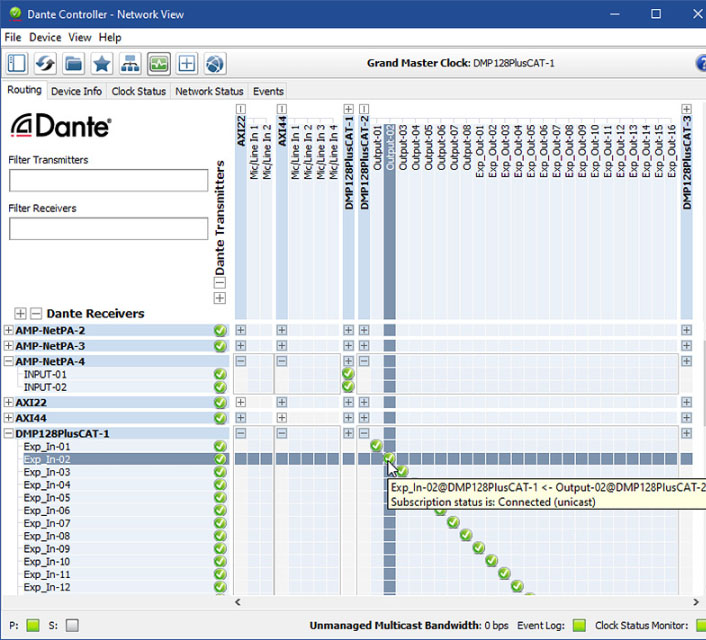
GLITCH-FREE REDUNDANCY
Many Dante-enabled devices support glitch-free, dual-link redundancy. A secondary network can be provided, simultaneously carrying an exact copy of the primary network’s audio traffic. Both networks run concurrently, enabling audio to continue uninterrupted if the primary network fails.
NETWORK HARDWARE
Dante is standards-based and supports easily available off-the-shelf Ethernet hardware and cabling. In most situations, you can simply plugin and begin passing audio, without the need to even configure switches.
In mission-critical applications where network stability is essential, switches compatible with Diffserv Quality of Service (QoS) can be configured to support the QoS priorities present in all Dante packets. QoS allows clocking synchronization and audio traffic to take priority over any other traffic sharing the network. This enables a typical Ethernet LAN used for email, Internet, and file transfer to be also used as a Dante audio network.
The new EEE (Energy Efficient Ethernet) functions deserve a special mention since they can interfere with real-time low latency audio traffic. We recommend careful testing for the correct operation of EEE-capable switches used with Dante, or selecting switches where EEE can be disabled. Gigabit Ethernet is preferred for Dante networks, due to its high bandwidth capacity. 100 Mbps Ethernet is also supported, but channel capacity will be reduced and latency will be higher.
For long-distance audio runs, Dante supports fiber optic connectivity.
DANTE VIRTUAL SOUNDCARD
Dante Virtual Soundcard is a simple, easy-to-use software application that connects desktop audio applications to the Dante network. As its name implies, it's a virtual soundcard that creates a Dante audio interface using your computer’s existing Ethernet port ? no additional hardware is required.
Using Dante Virtual Soundcard, a computer can easily integrate into the network as a Digital Audio Workstation for multitrack recording and playback, as a playback device for consumer audio applications (e.g., iTunes, Windows Media Player), or as an audio interface for Skype or other conferencing applications. Dante Virtual Soundcard supports ASIO and WDM on Windows and Core Audio on Mac OS X.


